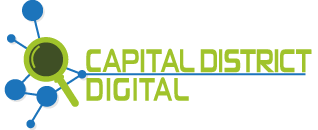A great website is key to a great business. Your website is a central location for your customers to find out information about your business, stay up to date on company news, and find how to contact you. With different functionality and features, customers could also see photos of your location, find your social media accounts, book an event, or pay online fees.
Whether you are creating a website for your company for the first time, or you are looking to make an update to your site we understand it can be overwhelming. To help make the process a little easier, we have put together a list of 10 elements every great website should have.
Watch Capital District Digital’s 10 Elements Every Great Website Should Have Video!
- Responsive Website Design for All Devices
Having a responsive website design means that your website will adjust to any device you are using whether it’s a desktop, tablet, or mobile phone. With technology increasing, people want to carry the smallest device possible for ease of use and comfortability. This means more websites are being viewed on mobile phones and tablets than desktops. Even though the screens are smaller in design it’s expected that the website holds the same speed, website design, and responsiveness as if they were being viewed on a desktop computer.
- Easy-to-Use Navigation
Navigation is extremely important for your website design. Your customer’s want to find the information they need easily, and in as little steps as possible. The most important location for navigating the website is in the header. You can also use navigation in the footer, sub menus, and sidebars. If you still worry people won’t be able to find what they are looking for, you can always add a search bar navigation to the site to make it easier for users.
- High Quality Photos
There is only so much reading one person wants to do on a website. Using high quality photos can make your company’s website design come to life. It can also be a great way to break up blocks of text throughout the site. Displaying photos of your location, employees, or events can really give your customers an inside look to learn more about your company.
- Social Media Integration
Integrating your social media with your website allows your customers to have more ways to share and engage with your content. Adding social media icons to your website design, either at the header or footer of your page, allows your customers to find your accounts and link directly to them.
Another option for integrating your social media into your website is adding social sharing links to your blog posts. Then, your customers will be prompted to share and interact with your blog posts. You can also have a feed of one or multiple of your social media accounts displayed on your homepage to make it more enticing for people to follow you.
- Security
Having a safe and secure website design is extremely important for both your company and your customers. What kind of security should you have? At the minimum, your website should have a SSL certificate, meaning that any users’ sensitive information such as credit card numbers or banking information will be encrypted. This makes it extremely difficult for any hackers to gain access to your customers valuable information. Adding Recaptchas to your contact forms is another way to block out spammers and hackers, making the communication on your site more secure.
- ADA Accessibility Menu
Every website should aim to be ADA compliant. However, at the very least, you should have an ADA Accessibility Menu on your website. This is a specific menu that assists people with disabilities to navigate your site easier. Some accessibility features on the menu include keyboard navigation, adjustments in the contrast and brightness of your website, bigger text, bigger cursors, and a read page option for the hearing impaired.
- Ecommerce Payment System
Some companies decide to have an ecommerce function if their website has an online store or bill paying option. If an ecommerce function makes sense for your company, having a payment system on your site can streamline the checkout process so they can complete the entire transaction without leaving your website.
- Branding
When developing your website design, you want to make sure that it doesn’t look like every other website in the world. It’s important to have a style and brand that is unique to your company and to display that cohesive look throughout your website. This way, you are making yourselves stand out from every other website in your industry and creating further brand recognition for your customers.
- Call-To-Action
Every website should have a clear Call-to-Action for your customers within every page. This is a link or button that clearly directs your customers to take a “next step” or action. An example of this could be a “Download Now” link for customers to download an instructional PDF. Other examples could be a “Contact Us” button to fill out a message on a contact form, or a “Book Now” button to book an appointment. It could even be something simple such as a “Learn More” link to learn more about a specific topic the page is covering.
- Blogging
When developing your website design, you want to make sure that it doesn’t look like every other website in the world. It’s important to have a style and brand that is unique to your company and to display that cohesive look throughout your website. This way, you are making yourselves stand out from every other website in your industry and creating further brand recognition for your customers.



